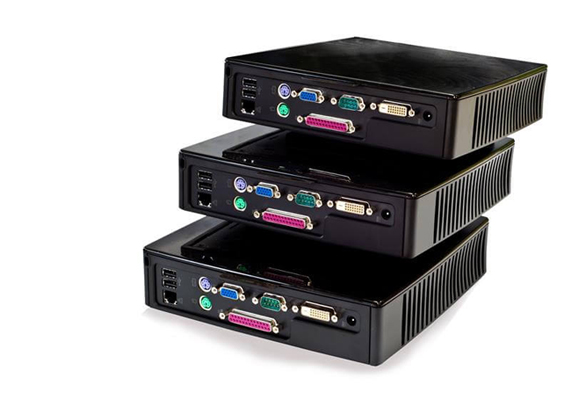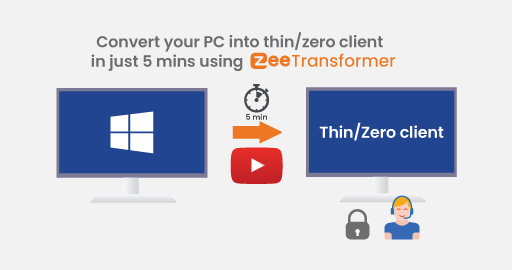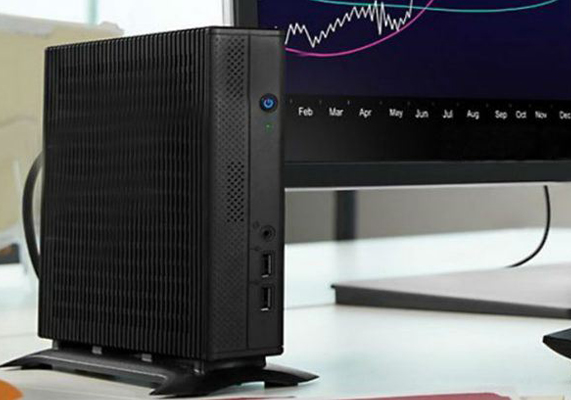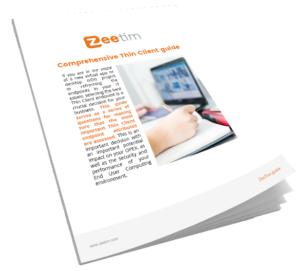What Are the Differences Between Thin Clients and Zero Clients?
Understanding the differences and making the right choice
If you are diving into a world of remote desktop and application end user computing, you are likely looking to centralize and ease the management of your environment, increase security, and provide users with great flexibility.
As part of the journey to VDI and remote applications, one of the areas to address is the end point, and you will likely be faced with the choice of either staying on Fat Clients/PCs (most likely Windows) and installing the connection protocol required, or opting for Thin Clients or Zero Clients.
Most admins are surely looking to move away from the first option of remaining on Fat clients /PCs due to expense, complexity, maintenance hassles, and security threats. They have just centralized their users apps and desktops so why should device management and setup remain decentralized and complicated?
Someone running a VDI environment no longer wants to worry about the endpoint device being vulnerable to viruses and the constant patching and updates that this requires. After all, most users will be using the device simply to access a remote application or desktop, and as such there is no need to complicate things. As a comparison with PCs, you still have the possibility to manage local Windows centrally with solutions such as Landesk, but with huge additional costs. There is a much simpler and more long term approach by introducing Thin clients or Zero Clients! Let’s start by going through the different flavors of each.
Let’s review the pros and cons of each in more detail:
Diving in to Thin Clients
Thin Clients are mini PCs, usually fanless and consuming minimal resources that typically run Linux or a stripped-down versions of Windows such as Win XPE, Windows 7 Embedded, or Win10 IOT.
Because Linux offers a more secure option as well as requiring less resources (RAM, CPU, Disc space), it is usually the recommended thin client platform. A ThinClient provides you with the flexibility of having a desktop with multiple applications, multiple access protocols, and the ability to work on locally installed applications. For example an administrator could configure a thin client to have access to both Citrix and VMware sessions, as well as the ability to browse locally on a Chrome or Firefox browser.
Thin client capabilities can also be restricted to the administrator’s desire through a central management console. Most thin client vendors provide powerful tools allowing for central device configuration and management.
Diving in to Zero Clients
With Zero Clients, you are still on a fanless mini PC which is very economical in terms of energy consumption, and from an OS perspective these are completely locked down to the protocol that they are meant for.
There are two types of Zero Clients that exist in the market including “System on Chip” ones who’s operating system is fixed to the processor on board, and others that are “Software Based” built on a Linux platform that is completely stripped down to supporting one protocol (i.e Microsoft RDP, Teradici PCOIP, VMware Blast, Citrix HDX – formerly ICA, RedHat Spice, and any other).
System on Chip Zero Clients are completely locked at the hardware level and cannot be converted to support a different protocol. For instance, if you opt for PCOIP Zero Clients with the Teradici chip, you will never be able to convert the unit to support Citrix or Redhat. On the other hand, if it is a software based Zero Client, it can be converted to a different protocol should the vendor in question allow this.
Because Zero Clients are completely fine tuned for a specific protocol, they tend to be very secure, likely use less resources, and be quite efficient in their operation. They are faster to boot than Thin Clients and sometimes handle graphics in a more ideal way (graphic cards come into play as well for this).
Comparison Table – Differences between all Thin Client vs. Zero Client varieties
| Zero Client System on Chip | Zero Client Software Based | Thin Client Windows | Thinclient Linux | |
|---|---|---|---|---|
| Boot Speed | Very Fast | Fast | Less Fast | Pretty Fast |
| Resource Requirements | Low but proprietary | Low | Moderate | Low |
| Performance | Good- only 1 protocol | Good- only 1 protocol | Good- multi protocol | Good- multi protocol |
| Vulnerability to Viruses | 0 Risk | 0 Risk | Minimal Risk | 0 Risk |
| Central Management Abilities | Limited only 1 protocol | Limited only 1 protocol- can be converted to another protocol (depends on vendor) | Flexible, with some limitations to aspects that can be controlled | Flexible, multiple protocols, multiple configs |
| OS Interchangeability | None | Interchangeable | Interchangeable | Interchangeable |
| Ability to run multiple apps | No | No | Yes | Yes |
| Peripheral Support | Depends on Vendor Dev & Support | Depends on Vendor Dev & Support | High (most drivers built for Windows) | Depends on Vendor Dev & Support |
What to know about vendor lock in
It is also important to note that certain vendors do allow for interchanging between different Operating Systems. The only caveat to this is that the device must contain the right amount of resources in terms of Memory and Disc space. One cannot move from a Linux Thin Client which requires only 8GB of flash disc space to a Windows Thin Client which requires a minimum of 16GB flash disc space. As such, it is good to know if your vendor allows for changing components such as RAM, and Flash Disc. Many vendors now solder in the memory so it is impossible to change, especially on less expensive or lower spec units.
The importance of testing
Whether you choose Thin Clients or Zero Clients, testing is extremely important. Every environment is unique and some environments are more complex than others. It is important to evaluate the endpoints based on user experience, and look into things such as application performance, graphics handling, and the support for peripherals (printers, scanners, signature pads, cameras, etc…). Peripheral support is usually one of the most important factors when deciding on Windows vs Linux thin clients or Zero Clients. Vendors with extreme competency will assist you in doing the utmost to make things work on a Linux device. It is also a good test of your vendor’s support capabilities. One must not get too enamored by things like a few seconds faster boot depending on zero vs thin client as most management platforms have a method of remote booting and shutting down endpoints based on schedules.It is also important to have an understanding of the likelihood that things will change in your environment. For instance, you may be using apps today that don’t require high graphical refresh rates so a lower spec thin client could work, but tomorrow you could add a mapping application which warrants a higher refresh rate. In this situation it is important to ask whether a difference of $50-$100 in spend per device warrants choosing a lower spec unit. After all, these units should have a life expectancy of at least 5 years as opposed to the 3 year typical life expectancy of a PC.
Click on the video below to see how you can convert your PC into a thin/zero client using ZeeTransformer.
ZeeTim’s Best of Both Worlds Approach with ZeeTerm.
ZeeTim approaches thin clients from the standpoint of providing customers with future proof devices that provide the maximum level of flexibility. The device Operating System is configured with a security first mindset, making the Linux ZeeOS that the devices use immune to any attack. Through the ZeeConf Management tool, the devices can be configured into either “Thin Client” mode or “Zero Client” mode. Administrators can interchange between both modes and lock down users based on what their needs are. This is done via a few clicks and drag and drops throughout the endpoint estate. With ZeeTim you can opt for a high spec reasonably priced HW device, or go for a Hardware of your choosing. You have complete flexibility and freedom to change! Depending on vendors, central management options are sold separately, or only basic features are provided with a thin client. ZeeTim is the only vendor providing you a complete central management platform included with the thin client. Need advice on what type of end point makes sense for you, schedule a FREE consultation with one of our experts. We are thin client vendors but we keep our consultancy general and will never push our devices unless this is requested.
Tags In
Search
Recent posts
- The main Cybersecurity risks of remote work: Safeguarding your infrastructure in a connected world 3 April 2024
- Introducing the latest version of ZeeScan! 22 February 2024
- Chromebooks in Business: Advantages and Challenges to Consider 19 February 2024
- Happy New Year from all of us at ZeeTim! 1 January 2024
- ZeeTim’s 2023 recap: Elevating end-user computing excellence 26 December 2023






